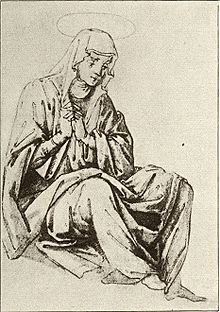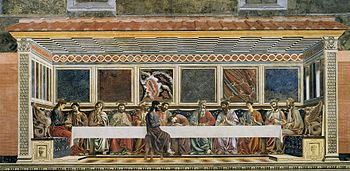Andrea del Castagno
Andrea del Castagno ( Andrea di Bartolo di Bargilla even Andrea dal Castagno di Mugello ; * about 1418 in the village of Castagno from San Godenzo ; † 19th August 1457 in Florence ) was an Italian painter of the Renaissance . He is counted among the most influential artists of the early Renaissance in Florence.
Life
Andrea del Castagno was born around 1418 in Castagno, a village near Monte Falterona not far from Florence . During the armed conflict between the Duchy of Milan and Florence, he lived in Corella and then returned to his home village, from where he moved to Florence in 1440. There he won the patronage of Bernadetto de 'Medici . On his behalf, after the Battle of Anghiari in 1440, he painted the pictures of the punished and hanged losers on the outer wall of a palace, which initially earned him the nickname Andrea degli Impiccati - "Andrea the Hanged Man". For him, however, the work marked the beginning of a long career.
Andrea del Castagno first worked as a fresco painter in the Church of San Zaccaria in Venice in 1442 . Then active in the area around Florence, he was involved in the Florentine-Venetian exchange of ideas. In his subsequent frescoes for the monastery of San Apollonia in Florence, the influence of the important master of the Florentine early Renaissance Domenico Veneziano and Piero della Francesca, who worked in Tuscany, can be seen . From 1444 he worked again mainly in Florence. There he also designed one of the round windows of the dome of Santa Maria del Fiore . He became a member of the Guild of Luke .
style
Castagno followed Masaccio's tradition of realism . Already in the 16th century Giorgio Vasari was still enthusiastic about Andreas central perspective and representations of perspective foreshortening, for example with Hieronymus in the Corboli chapel of Santa Annunziata. Castagno's coloring was probably rather inadequate, but e.g. B. the Last Supper (1447, San Apollonia) his pronounced talent for drawing. Later Castagno was under the influence of the sculptor Donatello .
Works (selection)
-
Frescoes in San Zaccaria in Venice, 1442
- The earliest surviving works by Castagno are his frescoes for San Zaccaria in Venice , from 1442.
-
Frescoes in the refectory of the Sant'Apollonia monastery in Florence, 1447
- In 1447 Castagno painted the refectory of the Benedictine monastery of Sant'Apollonia with frescoes, including The Last Supper and other scenes of the Passion of Christ, such as the crucifixion , burial and resurrection .
-
Frescoes of famous men and women , Villa Carducci near Florence, 1450
- One of the most famous works of Castagno are the nine frescoes of famous men and women from the Villa Carducci. These secular images with an almost statuesque effect were discovered in the 19th century, removed from the villa and brought to Florence, where they could be seen in the refectory (cenacolo) of the former monastery of Sant'Apollonia until the flood of 1966. Today they can be seen in the former Chiesa San Pier Scheraggio, a department of the Uffizi Gallery . They each represent three warriors, women and poets who were famous in the Renaissance: Pippo Spano , Farinata degli Uberti . Niccolò Acciaiuoli , Sibylle von Cumae , Queen Esther and Queen Tomyris as well as Dante Alighieri , Francesco Petrarca and Giovanni Boccaccio .
-
Frescoes in the Basilica della Santissima Annunziata in Florence, 1455
- Around 1455 Castagno painted frescoes in the Basilica della Santissima Annunziata in Florence. In various side chapels there he created pictures of St. Julian and St. Jerome and a picture of St. Trinity.
- Grave image of Niccolò da Tolentino. Florence Cathedral, 1456
- In 1456 Castagno painted the equestrian image of Niccolò da Tolentino , a fresco on his tomb in the cathedral of Florence .
Castagno and Veneziano
Giorgio Vasari reports in the second part of his biographies that Andrea killed Domenico Veneziano out of envy of his coloring. In fact, Domenico died four years after Andrea. Andrea probably died of the plague.
Castagno Museum
The Sant'Apollonia Monastery ( Cenacolo di Sant'Apollonia ) in Florence (Via San Gallo / Via XXVII Aprile) is now a Castagno Museum.
literature
- Eugenio Battisti: ANDREA di Bartolo, detto A. del Castagno. In: Alberto M. Ghisalberti (Ed.): Dizionario Biografico degli Italiani (DBI). Volume 3: Ammirato – Arcoleo. Istituto della Enciclopedia Italiana, Rome 1961.
- Werner Richard Deusch: Andrea del Castagno. Heilbronn 1928 (Königsberg i. Pr., Univ., Diss., 1928).
- Giorgio Vasari : Vita d'Andrea dal Castagno di Mugello e di Domenico Viniziano. In: Le vite dei più eccellenti architetti, pittori et scultori italiani. Edition Newton Compton Editori, Rome 2010, ISBN 978-88-541-1425-8 , p. 416 ff.
- Giorgio Vasari : The life of Lippi, Pesello and Pesellino, Castagno, Veneziano and Fra Angelico. Newly translated into German by Victoria Lorini. Ed., Commented by, introduced by Jana Graul and Heiko Damm. Verlag Klaus Wagenbach , Berlin 2011, ISBN 978-3-8031-5054-7 .
Web links
- Works by Andrea del Castagno at Zeno.org .
- List of works by Andrea del Castagno from the Fondazione Zeri of the University of Bologna
- Biography from Deutschlandradio
Individual evidence
- ↑ cf. Vasari
- ^ Carmela Thiele: Ingenious Renaissance draftsman 550 years ago the painter Andrea del Castagno died. on: Deutschlandradio. Calendar sheet August 19, 2007
- ^ Giovanni Ruccellais Lo Zibaldone
- ^ Andrea del Castagno, degli Impiccati . In: Friedrich Müller: The artists of all times and peoples. Stuttgart 1857.
- ↑ Musei Firenze website for the Cenacolo di Sant'Apollonia , accessed on October 5, 2013 (Italian)
| personal data | |
|---|---|
| SURNAME | Castagno, Andrea del |
| ALTERNATIVE NAMES | Andrea di Bartolo di Bargilla; Andrea dal Castagno di Mugello |
| BRIEF DESCRIPTION | Italian Renaissance painter |
| DATE OF BIRTH | around 1418 |
| PLACE OF BIRTH | San Godenzo |
| DATE OF DEATH | August 19, 1457 |
| Place of death | Florence |



